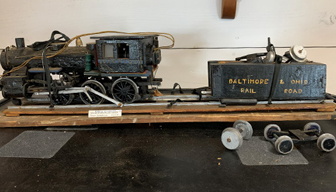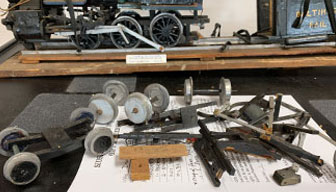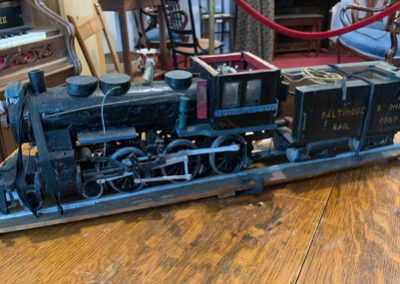It began with a chance “re-discovery” of a boxed up, wooden train in disrepair. Siuslaw Pioneer Museum curator, Sandy Zinn went searching for a spare box. She happened upon the tucked away treasure in a corner of the storage room. Opening the box she discovered a train in obvious need of TLC. Several wheels and various loose train parts were packed within the box. The discovery would soon reveal its historical significance.
A Call For Help
A Facebook picture and appeal for someone to perform the repair was posted. Fortunately, Lisa Dreher of Florence saw the post and contacted local resident Larry Fenstermaker. A hobby train enthusiast, Larry came to our rescue and kindly accepted the challenge.

IDENTIFYING THE TRAIN
The museum’s information about the train’s origin was sparse. The 2003 donor form read the train had been donated by Donald M. Loux. It referenced a name and Buck’s County, Pennsylvania. The donor had gifted two trains. One was a Harwick engine and passenger train. The second was the Baltimore & Ohio (B&O) Rail Road cargo train (now in need of repair). It is unknown when or how the train came to be in disrepair.
THE TASK
According to Larry, he laid the parts on his kitchen table to determine the extent of the task. A quick inspection revealed the original wood used for the train had shrunk over time. He established a self-imposed goal. He would return the train to its original state as best he could, using as much of the original parts in the process. Despite researching, he was unable to locate a match for the engine number. He determined the train is not an exact replica of a specific train. With the exception of the metal wheels, the train is handmade from wood. The underside of the tender car shows evidence of originating from a Girard cigar box. The other portions of the wood are of cedar and pine. In Larry’s opinion, while the train is not technically correct, he nonetheless describes it as “well done”. Undaunted by the challenge, he went about repairing the running gear parts. Wheels were reattached under the tender box, enabling the train to again roll forward and back on its rail platform. Broken or missing parts were fabricated or rebuilt by Larry. Using sticks spliced from other pieces of wood, he painted and distressed them to match the rest of the train. How the maker in that time period (late 1800’s) was able to make the wheels perfectly round remains a mystery.
While the other donated engine & passenger train displays the name Milton Harwick, the second train does not. However, in performing the repair, Larry noticed inside the tender cargo car, was the maker’s signage “MSH build”. Presumably this refers to Milton S. Harwick. Mr. Harwick (1851-1892) lived in Allentown, Pennsylvania where the B&O operated. It is likely he had seen the train on a regular basis, or perhaps even lived nearby.
TOO GOOD TO BE A NOVICE
Based on Mr. Harwick’s workmanship on both trains, Larry confirms Mr. Harwick was “too good to be a novice”. Proof of this can be seen in the gauges, piping, brake shoes, footsteps, hand-grabs, and glazed windows. Describing the detail as “excellent”, he suggests Mr. Harwick was likely experienced with wood carving, or fabrication. He was a talented, patient craftsman familiar with the finer details of the train. While not a true to scale model, “it is far better than a toy”. Larry wondered, could the parts have “possibly been turned on a lathe or sliced and laminated”? All the wood parts are hand carved with the exception of the wheels and metal trim on the sides. Larry describes it as a good representation of an actual coal burning steam locomotive, referred to as a 4-6-0 ten-wheeler.
TRAIN DESIGN
In comparing both trains, Larry pointed out the train painted in Royal Blue was a typical color for the Baltimore & Ohio passenger trains. Since freight engines are used to carry more weight, they are built larger than the passenger trains. He further explained the wheel height determines how fast a train is capable of traveling. The shorter wheels would result in less speed, but more power, thus able to pull heavier loads and more cars. Since the passenger train was designed for faster speeds, it would have been equipped with larger wheels. The museum’s Harwick trains however, have wheels of the same height, perhaps due to being the only size available to Mr. Harwick.
Thankfully for the museum, Larry Fenstermaker concludes it was an enjoyable project to work on and marvels at its remarkable detail, considering it was made prior to 1892.
Special Note: Larry Fenstermaker can be contacted by email at landl316@live.com.
Harwick Train Repaired
View GALLERY PAGE of additional train repair images.
Follow Up:
Larry and I discussed the materials used and what would have been availabe to Mr. Harwick in the late 1800’s. Mr. Harwick had utilized wooden cigar boxes for both of his trains donated to our museum. I guessed he must have enjoyed cigar smoking, or come by the boxes in another manner. A string or ribbon had been used to secure each train to their wooden platform. Larry suggested it was used to secure the train for transport purposes and are likely original to Mr. Harwick’s project. On closer inspection, we agreed it resembles a shoelace (although thinner), or a ribbon similar to today’s bias tape (used in sewing hems).
Intrigued, I researched Mr. Harwick’s occupation. I discovered in census records that Mr. Harwick’s occupation in 1882 was a cigar manufacturer and in 1889, a shoe maker.
View the Harwick trains and other exhibits at the Siuslaw Pioneer Museum. Open Wednesday through Sunday, noon to 4 p.m.







